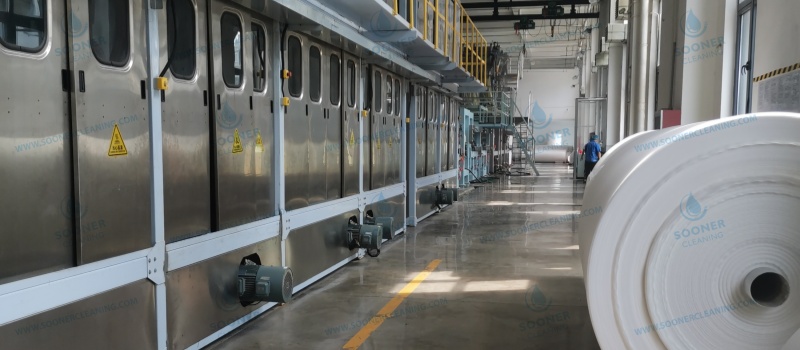Home>News
In-depth analysis of global industrial cleaning wipes market trends and opportunities
- 2025-04-03
In-depth analysis of global industrial cleaning wipes market trends and opportunities
(Based on market research and technology competition analysis in North America, Europe, and Asia-Pacific)
Global market status: growth drivers and regional differentiation
1. Market size and growth rate
The global industrial cleaning wipes market will reach $18 billion in 2024 and is expected to increase to $27 billion in 2030 at a CAGR of 6%. The core driving forces are manufacturing automation upgrades, stricter environmental regulations, and accelerated industrialization in emerging markets.
Regional perspective:
North America: The market size is expected to reach $5.5 billion in 2025, accounting for 30% of the global share, dominated by automotive and electronics manufacturing demand, 3M, Kimberly-Clark Brands such as K consolidate their position through anti-static wipes and high-precision dust-free products
Europe: Affected by the EU's "Single-Use Plastics Directive" (SUP), the demand for degradable wipes has surged. The German automotive manufacturing industry consumes more than 200,000 tons of wipes annually, and the growth rate of environmentally friendly products has reached 12%
Asia Pacific: The growth rate of the Indian and Southeast Asian markets leads the world (10%-15%), but the high-end market is still dominated by Japanese and Korean companies. Toray's nanofiber wipes have a market share of more than 40% in the semiconductor field
Competitive landscape and brand strategy
International giants: 3M has achieved a market share of 35% in the North American electronics manufacturing industry through the "technology patent + customization" strategy; Eagle Group has reduced costs by 30% with a closed-loop recycling system to seize the European environmental protection market.
Local breakthrough: India's Filantro First has entered the Southeast Asian food processing chain through bamboo fiber wipes, with prices 25% lower than European and American brands; China's Sinopec's brand has achieved import substitution in the petrochemical field with corrosion-resistant wipes.
Technology trend: Dual revolution of environmental protection and intelligence
1. Material innovation
Bio-based materials: The degradation cycle of polylactic acid (PLA) wipes has been shortened to 90 days, and the EU market penetration rate has increased from 12% in 2020 to 28% in 2024
Nanotechnology: The nano-coated wipes developed by Japan's Toray can absorb 0.1μm particles, improve cleaning efficiency by 50%, and the repurchase rate of semiconductor customers has reached 85%
2. Intelligent production and functions
IoT wipes: Germany's Karcher launched RFID chip embedded wipes, which monitor the number of uses and cleanliness in real time and reduce 20% of consumable waste
AI flexible production line: Berry Global in the United States uses AI slitting system, which increases order response speed by 50% and supports fragmented demand with a minimum order of 1 ton
Regional market in-depth insights and strategic recommendations
1. North American market: high-end and compliance
Pain points: Automakers face California AB 1276 Act, requiring a 50% reduction in VOC emissions from wipes
Opportunities: Promote water-based solvent wipes (VOC content <50g/L) and UL ECOLOGO certified products, and bind Tesla, GM and other supply chains.
2. European market: Green premium and circular economy
Policy dividends: Wipes that meet EPD (Environmental Product Declaration) can receive a 15%-20% EU procurement subsidy
Case: Tork in the Netherlands launched 100% recycled PET wipes. After passing GRS certification, its procurement share in companies such as IKEA and Philips increased to 30%.
3. Emerging markets: cost optimization and localization
Southeast Asia: Jointly launch economical wipes with a gram weight of 30-50g/m² with local distributors
Middle East: Develop high-temperature resistant (200℃) wipes for the oil industry, and build a joint laboratory with Aramco to shorten the certification cycle.
Enterprise competition strategy and investment hotspots
1. Construction of technical barriers
Patent layout: Focus on applying for flushable structures (such as EDANA SPD standard) and antibacterial coating patents to intercept imitation products
M&A cooperation: Refer to Berry Global's acquisition of Glatfelter, integrate spunlace nonwovens and wiping technology, and shorten the R&D cycle.
2. Channel and service system
Digital marketing: Establish an online selection tool, enter the industry and stain type to match the wipe parameters, and increase the conversion rate by 40%
After-sales value-added: Provide waste recycling services (such as a cash back of US$50 per ton of wipes) to enhance customer stickiness.
Risk warning and future outlook
1. Supply chain risk
The Russian-Ukrainian conflict caused the European polypropylene price to fluctuate by more than 25%. It is recommended to set up backup production capacity in Mexico/Eastern Europe.
2. Threat of technological substitution
Laser cleaning technology has a 5% replacement rate for metal industry wipes. It is necessary to accelerate the development of "wipes + detergent" integrated solutions
It is expected that by 2030, the proportion of green wipes will exceed 50%, and the penetration rate of smart wipes in the automotive and semiconductor fields will exceed 30%. Enterprises need to plan bio-based material production lines and data service capabilities in advance
- Previous article:No Records
- Next article:Tariff surge:spunlace industry breakthrough strategy-Updated March 27, 2025



